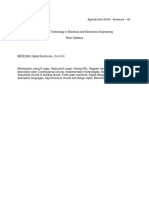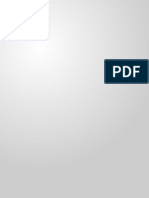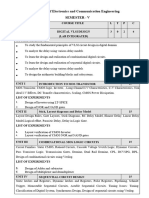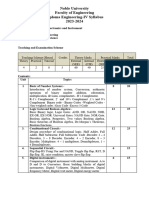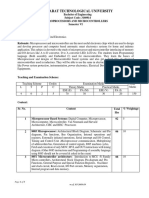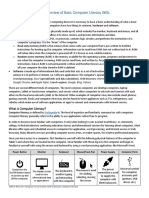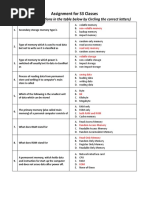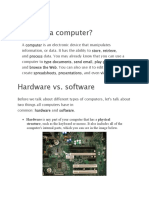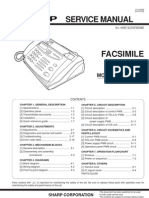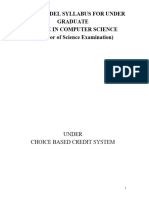Digital Logics
Digital Logics
Uploaded by
attitudeking565Copyright:
Available Formats
Digital Logics
Digital Logics
Uploaded by
attitudeking565Copyright
Available Formats
Share this document
Did you find this document useful?
Is this content inappropriate?
Copyright:
Available Formats
Digital Logics
Digital Logics
Uploaded by
attitudeking565Copyright:
Available Formats
SILVER OAK UNIVERSITY
College of Technology
Bachelor of Technology
Information Technology
Course Name: Digital Logics
Course Code: 1010083214
Semester: 3rd
Prerequisite:
1. Basic Electronics and Number Systems
Course Objectives:
1. The students need to learn basic concepts of digital circuits and systems which leads to the designof
complex digital systems such as microprocessors. The students need to know combinational and
sequentialcircuits using digital logic fundamentals. This is the first course by which students get exposure
to the digitalelectronics world.
Teaching Scheme:
Teaching Scheme
L T P Contact Hours Credit
3 0 2 5 4
Contents:
Unit Topics Teaching % Weightage
Hours
1 Binary Algebra, Codes and Registers: 5 10%
Binary arithmetic, one’s and two’s complements arithmetic, error
detecting and correcting codes
Binary Codes: Binary Coded Decimal (BCD), BCD addition, 2- 4-
2-1 Code, Excess-3 Code, 8-4-2-1 Code, Gray Code, Error
Detecting Code, ASCII Character Code.
Binary Storage and Registers: Registers, shift-registers, applications
of shift-registers, Register Transfer
2 Combinational Digital Circuits: 8 20%
Standard representation for logic functions, K-map representation,
and simplification of logic functions using K- map, minimization of
logical functions. Don’t care conditions, Multiplexer, De-
Multiplexer/Decoders, Adders, Sub-tractors, carry look ahead
adder, serial adder, digitalcomparator, parity checker/generator,
code converters, priorityencoders, decoders.
3 Sequential circuits and systems: 10 20%
SR flip flop, J-K-T and D types flip flops, applications of flip-
flops, serial to parallel converter, parallel to serial converter, ring
counter, sequence generator, ripple (Asynchronous) counters,
synchronous counters, counters design using flip flops,
asynchronous sequential counters, applications ofcounters.
4 A/D and D/A Converters: 9 20%
Digital to analog converters: weighted resistor/converter, R-2-R
Ladder D/A converter, specifications for D/A converters, examples
of D/A converter ICs, sample and hold circuit,
Analog to digital converters: quantization and encoding, parallel
comparator A/D converter, successive approximation A/D
converter, counting A/D converter, dual slope A/D converter,A/D
converter using voltage to frequency and voltage to timeconversion,
specifications of A/D converters, example of A/Dconverter ICs
5 Memory Architecture 5 10%
Semiconductor memories and Programmable logic devices (PLD):
Memory organization and operation, expanding memory size,
classification and characteristics of memories, sequential memory,
read only memory (ROM), read and write memory (RAM), ROM
as a PLD, Programmable logic array (PLA), Introduction to Hard
Disk Drive (HDD), Introduction to solid- state drive (SSD), Read
and Write Operations in Memory
6 Introduction To Verilog 9 20%
Introduction to Hardware Description Languages (HDL), Verilog
Introduction, Verilog Logical System, Verilog Nets and Wires,
Verilog Internal Variables, Verilog Numbers, Vectors and Bit
Selection, Verilog Operators, Verilog Built-in Gates, Continuous
and Non-continuous Assignments, if statement, Case Statement,
For looping statement.
Course Outcomes:
Sr.
CO Statement Unit
No.
Solve the given problem Related to Encrypt Data using fundamentals of 1
CO-1
Binary Codes.
Analyze working of Registers, logic gates and design the simple circuits 2,6
CO-2
using various gates for a given problem
CO-3 Design and implement Combinational and Sequential logic circuits and 2,3,6
CO-4 verify its working 4
Examine the process of Analog to Digital conversion and Digital to Analog 5
CO-5
conversion
Teaching & Learning Methodology:
1. Direct Instruction
2. Flipped Classrooms
3. Kinesthetic Learning
List of Experiments: Total Hours: 28
Sr. No. Practical Name
1 To study in detail about cloud computing.
2 Installation and Configuration of Oracle Virtual Box/VMware.
3 Study and implementation of infrastructure as Service using Open Stack.
4 Install Turbo C in guest OS and execute C program.
5 Test ping command to test the communication between the guest OS and Host OS.
6 Develop a Hello World application using Google App Engine.
7 Study about the Cloud simulation tools. Install CloudSim and analyze the working of
CloudSimsimulator.
8 Case Study: PAAS(Facebook, Google App Engine)
9 Case Study: Amazon Web Services.
Books Recommended:
1. "Digital logic and Computer design", M. M. Mano, Pearson Education India, 2016.
2. "Fundamentals of Digital Circuits ", A. Kumar, Prentice Hall India,2016.
3. “Digital Principles and Applications” Malvino & Leach, McGraw-Hill Education
4. "Modern Digital Electronics", R. P. Jain, Mc Graw Hill Education,2009.
List of Open-Source Software/learning website:
1. LogiSim software
2. Xilinx
3. Eda Playground
4. Xcircuit
5. Scilab
6. NPTELwebsite
7. https://www.vlab.co.in/
8. www.silveroakuni.ac.in
You might also like
- Cnc-200A User Manual Ver. H8681/3Document14 pagesCnc-200A User Manual Ver. H8681/3Cristiano Martinez100% (2)
- ICT-CSS12 Q1 Mod2Document36 pagesICT-CSS12 Q1 Mod2Jonathan PalerNo ratings yet
- (GUIDE) Making Dump Files Out of Android Device PartitionsDocument11 pages(GUIDE) Making Dump Files Out of Android Device Partitionsmuji onoNo ratings yet
- Gujarat Technological University: W.E.F. AY 2018-19Document4 pagesGujarat Technological University: W.E.F. AY 2018-19useless9925No ratings yet
- PDFDocument4 pagesPDFArpit PatelNo ratings yet
- DSD Syll - Merged DSD GtuDocument8 pagesDSD Syll - Merged DSD GtuSandeep kumarNo ratings yet
- Gujarat Technological University: W.E.F. AY 2018-19Document3 pagesGujarat Technological University: W.E.F. AY 2018-19Alok MauryaNo ratings yet
- Digital Electronics TEE: CO1 CO2 CO3 CO4 CO5 CO6Document2 pagesDigital Electronics TEE: CO1 CO2 CO3 CO4 CO5 CO6Anonymous HyOfbJ6No ratings yet
- BCA Sem1 2023 Major PapersDocument7 pagesBCA Sem1 2023 Major PapersSutonuka BhattacherjeeNo ratings yet
- BEEE206L - DIGITAL-ELECTRONICS - TH - 1.0 - 67 - Digital ElectronicsDocument3 pagesBEEE206L - DIGITAL-ELECTRONICS - TH - 1.0 - 67 - Digital ElectronicsNithish kumar RajendranNo ratings yet
- Bca Major Syllabus - 1ST SemDocument6 pagesBca Major Syllabus - 1ST Sempradipta.sarkarNo ratings yet
- EC4002 - Digital Logic DesignDocument5 pagesEC4002 - Digital Logic DesignTarangNo ratings yet
- GTU Digital ElectronicsDocument3 pagesGTU Digital Electronicssjbv.hardik582No ratings yet
- Demulti Plexer and MultiolexerDocument7 pagesDemulti Plexer and Multiolexerkaran007_mNo ratings yet
- Digital ElectronicsDocument4 pagesDigital Electronicskimajam628No ratings yet
- FDH Digital Logic DesignDocument3 pagesFDH Digital Logic Designzainhassann44No ratings yet
- B.tech Cse VTR Uge2021 de SyllabusDocument4 pagesB.tech Cse VTR Uge2021 de SyllabusBOLLIGARLA MOHAN SAI AKASH,CSE2021 Vel Tech, ChennaiNo ratings yet
- 2131004Document3 pages2131004Parthiv Oza MasterMindNo ratings yet
- Digital Logic DesignDocument2 pagesDigital Logic Designshagunrtn4No ratings yet
- Subject Made Easy - Digital ElectronicsDocument21 pagesSubject Made Easy - Digital Electronicsradha_chaudhary20034343100% (1)
- 1st Year SyllabusDocument7 pages1st Year Syllabuschhotonroy98745No ratings yet
- EE204 Digital Electrncs N Logic DesignDocument3 pagesEE204 Digital Electrncs N Logic DesignsaniljayamohanNo ratings yet
- BoschDocument7 pagesBoschDILEEPKUMARRRNo ratings yet
- Course Information Sheet: Sir Syed University of Engineering & Technology Electronic Engineering DepartmentDocument6 pagesCourse Information Sheet: Sir Syed University of Engineering & Technology Electronic Engineering DepartmentAbdullah SohailNo ratings yet
- Digital Eelectronics SyllabusDocument4 pagesDigital Eelectronics Syllabuskbp.amdNo ratings yet
- SyllabusDocument183 pagesSyllabusGayathri PriyaNo ratings yet
- NU (DIGITTAL ELECTRONICS AND INSTRUMENTS) LatestDocument2 pagesNU (DIGITTAL ELECTRONICS AND INSTRUMENTS) Latestkhushalee.chavadaNo ratings yet
- DE Course Plan2020Document10 pagesDE Course Plan2020Charu PathakNo ratings yet
- COMSATS Institute of Information Technology Abbottabad: GoalsDocument2 pagesCOMSATS Institute of Information Technology Abbottabad: GoalsSohail MashwaniNo ratings yet
- DE Syllabus UPESDocument2 pagesDE Syllabus UPESAbhay ChaudharyNo ratings yet
- Cse1003 Digital-logic-And-Design Eth 1.1 47 Cse1003Document8 pagesCse1003 Digital-logic-And-Design Eth 1.1 47 Cse1003Shiva Charan0% (2)
- Gujarat Technological University: Semester - III Subject Name: Digital ElectronicsDocument3 pagesGujarat Technological University: Semester - III Subject Name: Digital ElectronicsBhargavsinh ParmarNo ratings yet
- DLD Theory F23Document4 pagesDLD Theory F23Imran Ahmad AhmadNo ratings yet
- Digital SystemsDocument390 pagesDigital SystemsKetan PandeyNo ratings yet
- Gujarat Technological University: Page 1 of 5Document5 pagesGujarat Technological University: Page 1 of 5Keval PatelNo ratings yet
- 24EC102Document3 pages24EC10223102208No ratings yet
- Ece103 Digital-logic-Design Eth 1.10 Ac29Document2 pagesEce103 Digital-logic-Design Eth 1.10 Ac29netgalaxy2010No ratings yet
- Obe Curriculum For The Course: RGPV (Diploma Wing) BhopalDocument22 pagesObe Curriculum For The Course: RGPV (Diploma Wing) BhopalHarshit Sahu CS-26No ratings yet
- TECP3851-Microprocessor and Programmable Logic ControllersDocument1 pageTECP3851-Microprocessor and Programmable Logic ControllersSteveNo ratings yet
- Electronics 4Document4 pagesElectronics 4drkhamuruddeenNo ratings yet
- Curriculum Details of Y-3 T-1Document29 pagesCurriculum Details of Y-3 T-1Mr. KamaruzzamanNo ratings yet
- EE 122 Digital ElectronicsDocument3 pagesEE 122 Digital Electronicslevisqueen26No ratings yet
- BTEL13501 Microprocessor and Microcontroller Sem5 Final NVS DBDocument4 pagesBTEL13501 Microprocessor and Microcontroller Sem5 Final NVS DBspservice461No ratings yet
- 3.1 Digital Electronics: RationaleDocument20 pages3.1 Digital Electronics: RationaleHari GNo ratings yet
- Gujarat Technological UniversityDocument3 pagesGujarat Technological UniversitymamathaursNo ratings yet
- 2.digital Electronics TheoryDocument15 pages2.digital Electronics TheoryYash KuncolienkerNo ratings yet
- CseaDocument2 pagesCseaomstudyingpandey363No ratings yet
- Course File Final Heena A DigitalDocument23 pagesCourse File Final Heena A DigitalraghuippiliNo ratings yet
- NUST Syllabus For DLDDocument2 pagesNUST Syllabus For DLDwistfulmemory100% (1)
- Digital ElectronicsDocument228 pagesDigital ElectronicsMujeeb AbdullahNo ratings yet
- Cu 1st SemDocument4 pagesCu 1st SemCOMPUTER SCIENCE BGCNo ratings yet
- 9 - 28 - 0 - 0 - 40 - 5th Electrical DE&MPDocument165 pages9 - 28 - 0 - 0 - 40 - 5th Electrical DE&MPvijay kumar GuptaNo ratings yet
- EEE241-DLD Course OutlineDocument2 pagesEEE241-DLD Course OutlineZeeshan TahirNo ratings yet
- Gujarat Technological University: Page 1 of 3Document3 pagesGujarat Technological University: Page 1 of 3Breeje AnadkatNo ratings yet
- Embedded Lab ManualDocument8 pagesEmbedded Lab ManualAlazmi Faleh50% (2)
- ECT 206 Computer Organization and Microcontroller-SyllabusDocument8 pagesECT 206 Computer Organization and Microcontroller-SyllabusVilayil jestinNo ratings yet
- 2 Digital Principles Assignment Outcome 1 2 3 4Document7 pages2 Digital Principles Assignment Outcome 1 2 3 4Nada Mostafa MahmoudNo ratings yet
- CS2031 Digital Logic Design OBE AdnanDocument4 pagesCS2031 Digital Logic Design OBE Adnanseemialvi6No ratings yet
- Syllabus 2140910Document4 pagesSyllabus 2140910Hardik AgravattNo ratings yet
- The Secret of Logic Gates: Unveiling the Power of Light Dependent ResistorsFrom EverandThe Secret of Logic Gates: Unveiling the Power of Light Dependent ResistorsNo ratings yet
- Introduction to Digital Systems: Modeling, Synthesis, and Simulation Using VHDLFrom EverandIntroduction to Digital Systems: Modeling, Synthesis, and Simulation Using VHDLNo ratings yet
- Build Logic Gates with Universal NAND: CMOS and TTL in ActionFrom EverandBuild Logic Gates with Universal NAND: CMOS and TTL in ActionNo ratings yet
- ICT ICF Lesson Outline 2Document2 pagesICT ICF Lesson Outline 2lorenzo aoalinNo ratings yet
- Floboss 103 and 104 Flow Manager Instruction Manual: Part Number D301153X012Document106 pagesFloboss 103 and 104 Flow Manager Instruction Manual: Part Number D301153X012Mauricio RoldanNo ratings yet
- Java Ring PPTDocument18 pagesJava Ring PPTReval RamakrishnanNo ratings yet
- An Overview of Basic Computer Literacy SkillsDocument5 pagesAn Overview of Basic Computer Literacy SkillsV3RD 4OLSNo ratings yet
- LT-Z26SX5 - Z32SX5 CH - FL2 (sm-YA327)Document192 pagesLT-Z26SX5 - Z32SX5 CH - FL2 (sm-YA327)Roberd MihailovNo ratings yet
- 8051 Unit 1 NotesDocument19 pages8051 Unit 1 NotesSOMESH B S100% (13)
- Assignment For S3 Classes: (Answer All Questions in The Table Below by Circling The Correct Letters)Document3 pagesAssignment For S3 Classes: (Answer All Questions in The Table Below by Circling The Correct Letters)Berard JulesNo ratings yet
- Du An Nam Rom - MSGDocument3 pagesDu An Nam Rom - MSGLiem Pham ThanhNo ratings yet
- AN2295 - Developer's Serial Bootloader For M68HC08 and HCS08Document56 pagesAN2295 - Developer's Serial Bootloader For M68HC08 and HCS08wangNo ratings yet
- Lesson 4: Perform Mensuration and Calculation (MC) : TVL-Information & Communication Technology 2D Animation NC IiDocument13 pagesLesson 4: Perform Mensuration and Calculation (MC) : TVL-Information & Communication Technology 2D Animation NC IiEdward Barber0% (1)
- Booklet of Computer.Document27 pagesBooklet of Computer.Shahzad Raza JalbaniNo ratings yet
- Add Info B-63524EN 01Document39 pagesAdd Info B-63524EN 01Douglas OteroNo ratings yet
- Itm - SyllabusDocument50 pagesItm - Syllabusbabupradhan452No ratings yet
- What Is A ComputerDocument60 pagesWhat Is A ComputerJc CapistranoNo ratings yet
- Ux 255Document75 pagesUx 255flavio_b_7039No ratings yet
- FCS - BcaDocument1 pageFCS - Bcabalaanand_mcaNo ratings yet
- Computer Notes by JKSSB Study FastDocument24 pagesComputer Notes by JKSSB Study FasthoesussanahNo ratings yet
- Unit - 3 Loc-Ii NotesDocument54 pagesUnit - 3 Loc-Ii NotesVedikanushthan sanghNo ratings yet
- PIC Microcontrollers - Programming in C - Free Online Book - Mikroelektronik - Spanish PDFDocument195 pagesPIC Microcontrollers - Programming in C - Free Online Book - Mikroelektronik - Spanish PDFAaron YoungNo ratings yet
- PC Packages - I 16CACCA1A I Bcom Ca: Study Material Prepared by .Document111 pagesPC Packages - I 16CACCA1A I Bcom Ca: Study Material Prepared by .sathyaNo ratings yet
- 8666 (Netfinity 7100) Hardware Manitenance ManualDocument198 pages8666 (Netfinity 7100) Hardware Manitenance Manualjoe_watson4777No ratings yet
- Hillcrest 1st Term ExamDocument34 pagesHillcrest 1st Term ExamOyinade AdeoluNo ratings yet
- Nutshell IctDocument7 pagesNutshell IctberringtonhardyNo ratings yet
- Computer Mcqs For Acc ExamDocument92 pagesComputer Mcqs For Acc ExamSrikanth SriNo ratings yet
- Chapter 1Document34 pagesChapter 1Arlyn ElsiNo ratings yet
- Computer Sc.-SyllabusDocument49 pagesComputer Sc.-SyllabusSandipNo ratings yet
- Computers and Quantity Surveyors (PDFDrive) PDFDocument217 pagesComputers and Quantity Surveyors (PDFDrive) PDFsitrakiniavoNo ratings yet









